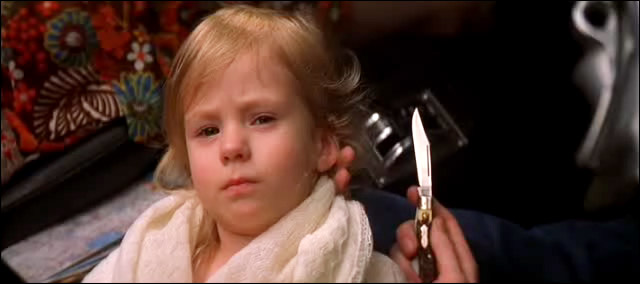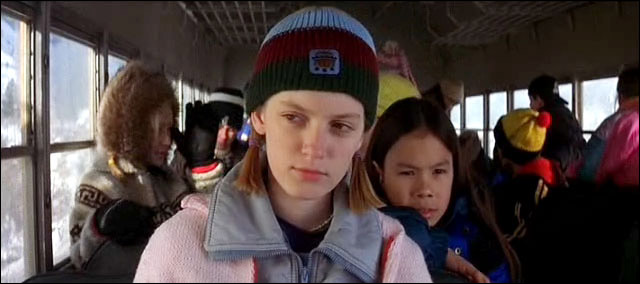

The Sweet Hereafter
Premise
Evaluation Lesson one: when you're mentally translating every look and gesture you see into screenplay language, everyone appears to be overacting. As a lay viewer, I'd loved this movie; this time around, as I reverse-engineered the instructions — "Look shocked!" "Look uncomfortable!" — I found myself pining for some subtlety. (Sarah Polley was the exception.) Lesson two: when you're cataloguing the lines and actions given to each character, you find that there aren't actually a whole hell of a lot of them, especially in an ensemble piece like this. This makes the characters seem much flatter than they do when you're watching as a lay viewer, supplying your own depth along the way. Lesson three: don't watch movies this way.
Commentary
 Take Sarah Polley's character, Nicole Burnell. In my initial viewings, I didn't try to interpret her — I just fell in love with her. She's not an outcast, but she's not horsing around with the other teenagers; she's not motherly, but she's a beloved source of support to the younger kids; she's not a leader, but every time she rides the school bus she sits in the front. She sits in the front, looks out the window, and thinks. And on the soundtrack? I found an early draft of the screenplay in which she does a lot of voiceover work. In the released film, almost all of that has been cut. Instead— she sings. Like an angel. The Sweet Hereafter became my favorite movie because as the movie unfolded, all of the tragedy and triumph therein was amplified by the fact that it was happening to someone I deeply cared for. But this time I could see the work that Egoyan was doing in turning the Nichole of the novel into the much stronger character of Nicole in the movie. In both versions of the story, she's being sexually exploited by her father. Nichole is furious and sick about this from the get-go. Nicole, by contrast, is initially a willing participant, only to turn on her father after the accident. Previously, I had seen this change of heart as just part of the randomness and inexplicability of life; now it seemed incredibly obvious that it was a necessary element of Egoyan's thematic schema. You can imagine a timeline labeled NICOLE with a vertical line through it marked ACCIDENT. Before the accident, she is a child, and goes along with her father because she is subservient. Before the accident, she is an innocent, and sees their moments in the hayloft as romantic. But then the bus plunges off the cliff and Nicole is introduced to the horrors of the world. No longer innocent, she can see what has been happening to her for what it is: not an affair, but incestuous molestation. And no longer a child, she can fight back with intelligence and guile. Nicole is a portrait of innocence lost but virtue retained. The movie accepts that she has to become a calculating adult in order to become an effective force for good, and at the same time appreciates that the loss of the sweet kid she was before is something to mourn. That's quite something! What an interesting and ambitious locus of themes! And yet I liked her better when she was a person. Example #2: Alison, the young woman whom the lawyer, Mitchell Stephens, meets on the plane. Here's the setup: Stephens came to town and rounded up as many bereaved parents as he could to join a suit against, well, against anyone he could think of — the bus company, the guardrail builders, the city, you name it. He wouldn't accept that no one was to blame for the deaths of these children, that it was just an accident, a patch of ice in the wrong place. Someone had to be to blame, someone he could sue. Why? Money was certainly a part of it, but mainly it was a way of dealing with his demons. His own daughter, Zoe, is a drug addict who has spent the past few years calling him from faraway cities demanding money. Whose fault is that? Hers, his, society's, everyone's, no one's. But the idea that there's no simple explanation for anything important is something he can't handle. Now Stephens is on a plane, and through sheer coincidence he finds himself seated next to one of Zoe's childhood friends. Alison serves as his sounding board as he narrates the most harrowing sequence in the film, one that has nothing to do with the bus crash: the time that Zoe, as a toddler, was bitten by spiders and had to be taken to the hospital while Stephens held a knife next to her throat anticipating that she would soon stop breathing and that he would have to give her an emergency tracheotomy. The story is a microcosm of the entire movie — both are about the problem of children. Losing Zoe is a terrifying prospect, the most excruciating thing imaginable... and yet, four years earlier life without Zoe wasn't so very bad. ("Why do we fear the eternity of oblivion after we die, but not the eternity of oblivion before we are born?") Why do we bring these creatures into the world that we then can't bear to lose — especially considering that, one way or another, we lose them anyway? That's the irony of the spider story, after all: the Stephenses make it to the hospital in time and Zoe is saved... only, ultimately, she isn't, because the future of that little girl on Mitchell's knee is to wail at him from a phone booth because he won't wire her any more drug money. Now, just as I had a sense of Nicole's character before I was able to diagram it, I had a sense that having someone like Alison be the one listening to Stephens made for a richer scenario than if it were Phil from Bala, Ontario. But this time around her purpose in the film seemed completely obvious: she serves as an avatar of who Zoe would be in an ideal world. When Stephens steps off the plane he sees a young father laughing with his toddler daughter, and then Alison stops him to say goodbye — Alison, this bright 30-year-old woman, old enough and together enough to treat as an equal. The cut from the girl to the woman is a narrative, the narrative of why people have children, the narrative that Zoe's addiction has stolen from him. Apparently it's also a standard formula. Bah. Lesson four: reread lesson three.
Return to the Calendar page! |
